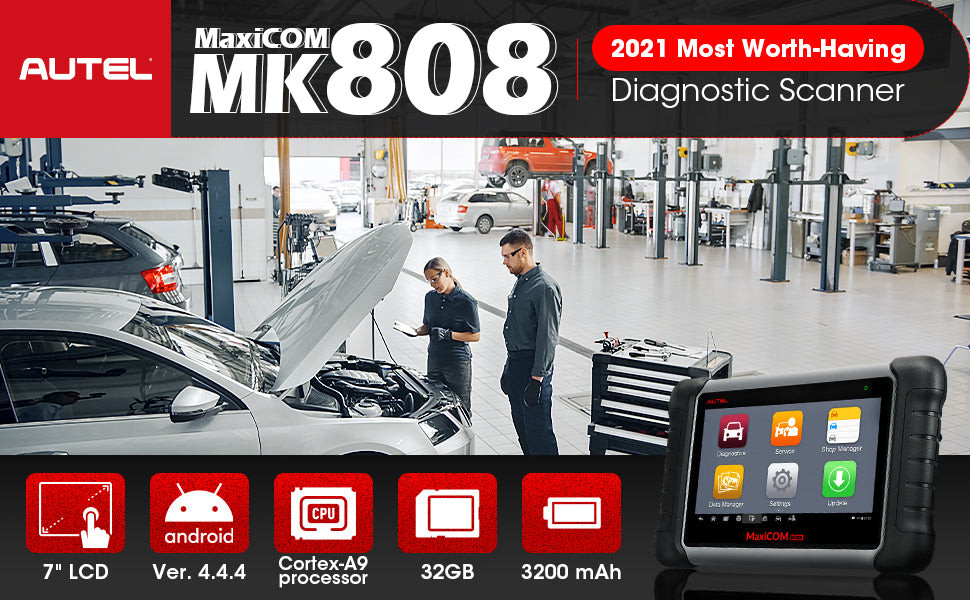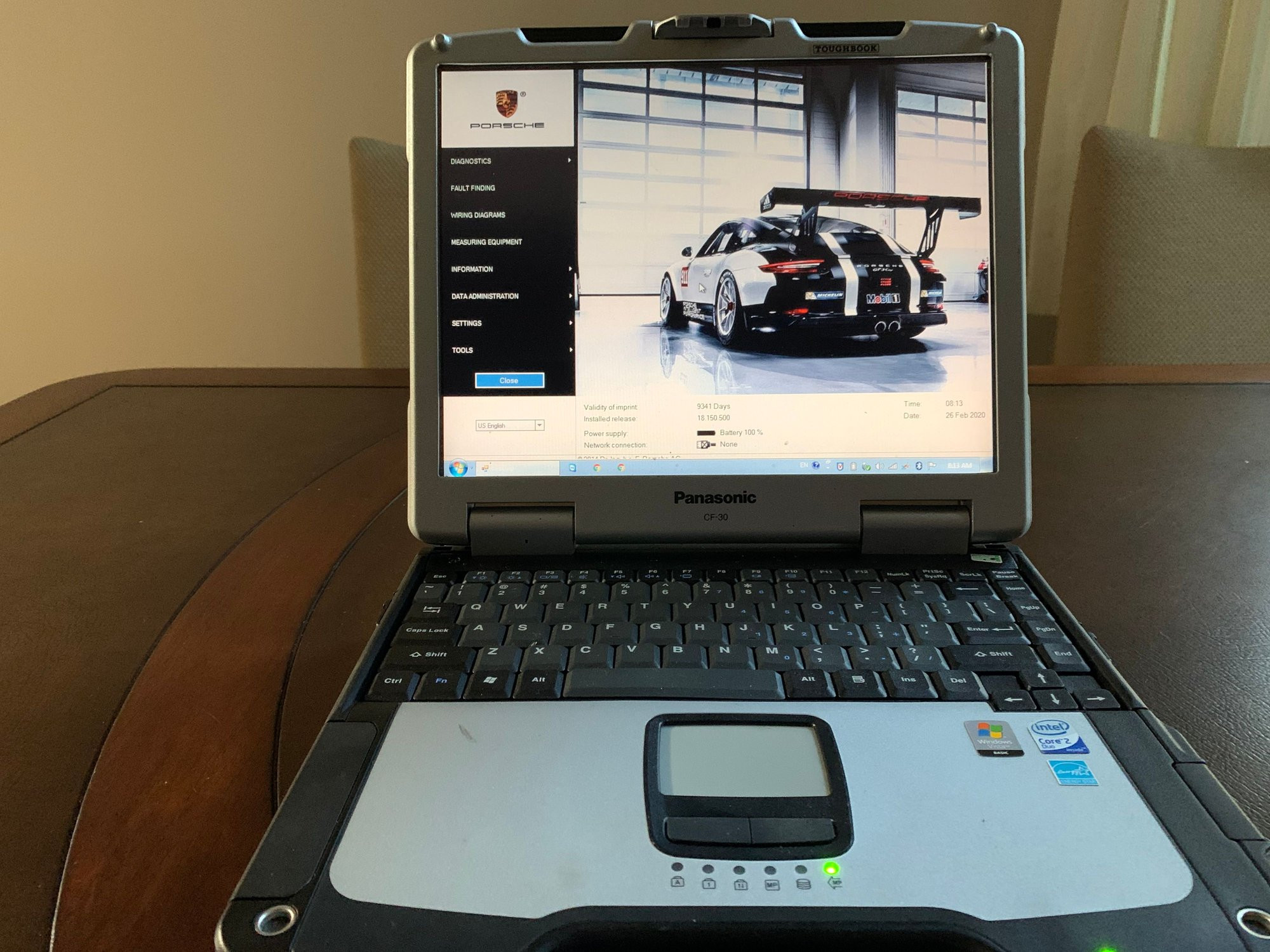What is DoIP? A Comprehensive Guide to Diagnostic Over Internet Protocol
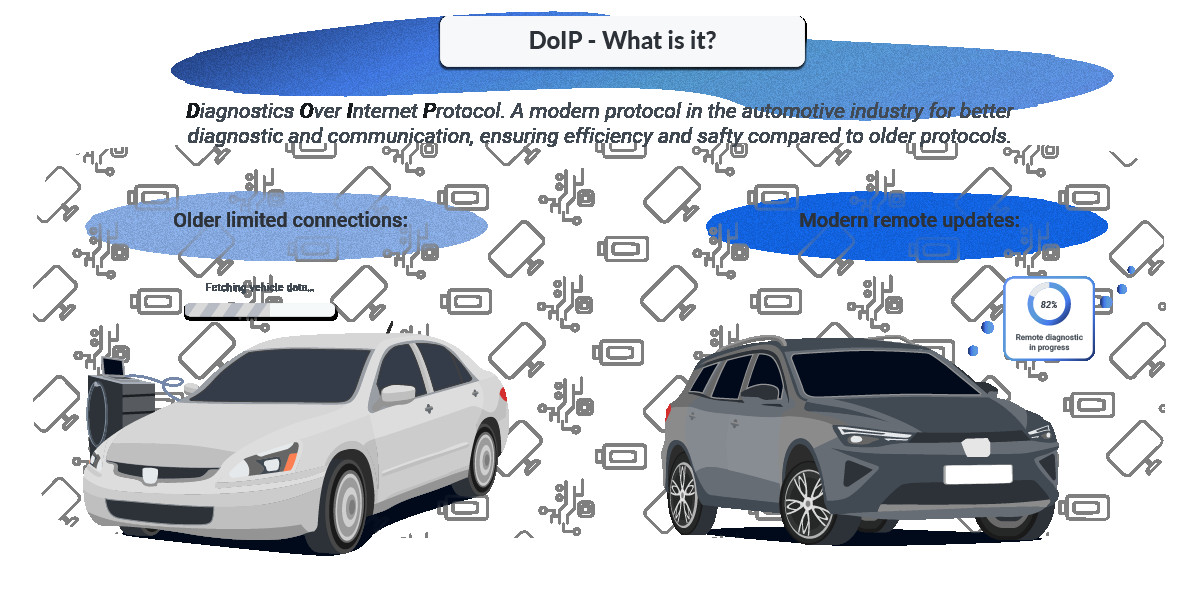
In the rapidly evolving automotive industry, vehicle diagnostics have become increasingly complex. Modern vehicles are sophisticated systems comprising numerous interconnected electronic components and software, demanding advanced diagnostic solutions. Diagnostic over Internet Protocol (DoIP) has emerged as a pivotal technology, revolutionizing how vehicles are diagnosed, maintained, and updated. This article delves into the intricacies of DoIP, exploring its functionality, applications, benefits, and its role in shaping the future of automotive diagnostics.
 Illustrations of a two cars representing DoIP abilities and abbreviation
Illustrations of a two cars representing DoIP abilities and abbreviation
Understanding the Fundamentals of DoIP
DoIP, short for Diagnostic over Internet Protocol, is a cutting-edge vehicle diagnostic protocol that operates over standard IP networks. Unlike legacy diagnostic methods that relied on direct physical connections and protocols like CAN or K-Line, DoIP leverages network infrastructure for communication. This transition to network-based diagnostics is crucial for modern vehicles characterized by intricate electronic architectures and the need for frequent software updates.
The genesis of DoIP can be attributed to the growing demands for more efficient and versatile diagnostic techniques as vehicles became more technologically advanced. Traditional diagnostic systems were constrained by the limitations of connection speed and range. The proliferation of the internet and network technologies paved the way for DoIP, enabling faster data transmission and remote diagnostic capabilities.
Technical Specifications of DoIP
DoIP is built upon a robust set of technical specifications that ensure reliable and high-performance diagnostic communication.
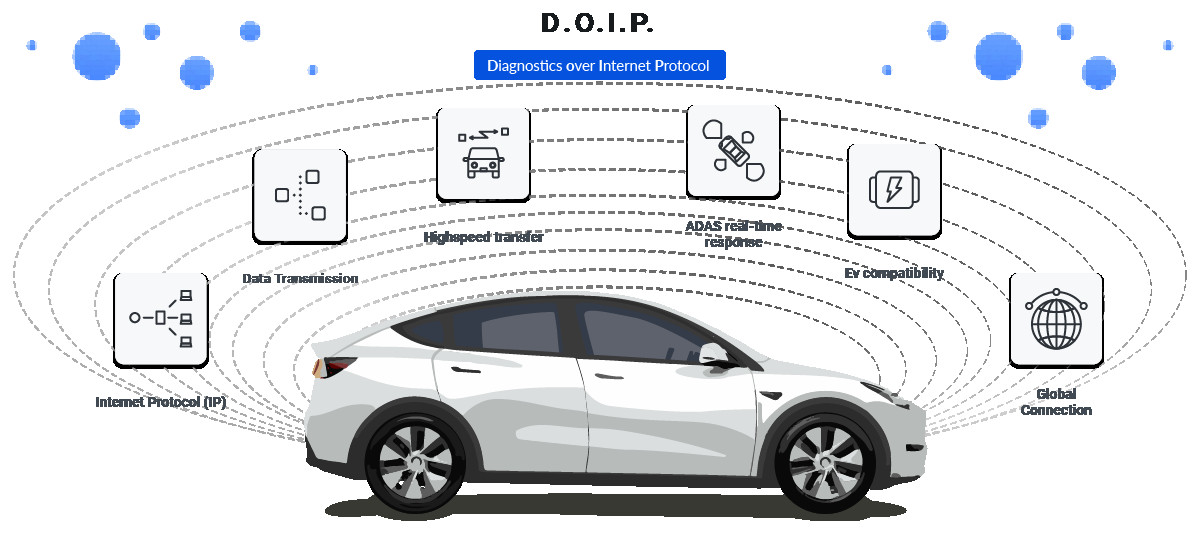 Illustration of DoIP and the modern technical Specifications there is to it
Illustration of DoIP and the modern technical Specifications there is to it
- Protocol Foundation: At its core, DoIP is based on the Internet Protocol (IP) suite, allowing it to function seamlessly across any IP-compatible network, including Ethernet.
- ISO Standardization: DoIP is standardized under ISO 13400, a comprehensive standard that defines the protocols and procedures for data transmission and security over IP networks in automotive diagnostic applications. This standardization ensures interoperability and consistency across different vehicle manufacturers and diagnostic tools.
- High-Speed Data Transfer: DoIP facilitates high-speed data exchange between diagnostic equipment and vehicle systems. This capability is essential for efficiently handling large volumes of data required for comprehensive diagnostics and rapid software updates in modern vehicles.
- Network Flexibility: DoIP’s network-centric nature allows for remote diagnostics and software updates, eliminating the need for physical proximity to the vehicle. This is particularly advantageous for geographically dispersed fleets and over-the-air (OTA) updates.
DoIP represents a paradigm shift towards interconnected and remotely accessible vehicle systems, which is indispensable for supporting:
- Advanced Driver-Assistance Systems (ADAS): ADAS, with their complex algorithms and real-time data processing requirements, benefit significantly from DoIP’s faster diagnostic and update capabilities, ensuring optimal performance and safety.
- Electric Vehicles (EVs): EVs rely heavily on sophisticated software to manage battery systems, power electronics, and vehicle control functions. DoIP enables efficient software management and diagnostics for these critical EV components.
- Global Automotive Operations: For vehicle manufacturers and service providers operating globally, DoIP streamlines diagnostics and software updates across vast distances, minimizing downtime and reducing operational expenses.
Applications of DoIP in Modern Automotive Technology
DoIP is transforming automotive servicing and maintenance in an era of rapid technological advancement. This sophisticated protocol enhances conventional practices and introduces a new era of diagnostic possibilities. DoIP empowers real-time troubleshooting and efficient updates, whether performed in a workshop or remotely, creating a streamlined and effective process for manufacturers, technicians, and vehicle owners.
Here are key applications of DoIP in the automotive sector:
- Remote Diagnostics: DoIP enables technicians to perform diagnostics remotely, reducing the necessity for physical service appointments and minimizing vehicle downtime. This is particularly beneficial for fleet management and remote areas where immediate on-site service may not be feasible.
- Over-the-Air (OTA) Software Updates: Vehicles equipped with DoIP can receive the latest software updates wirelessly, ensuring they always have the newest features and enhancements without requiring a physical service visit. OTA updates are crucial for addressing software glitches, improving performance, and adding new functionalities to vehicles throughout their lifecycle.
- Manufacturing and Quality Control: DoIP’s capabilities extend to the vehicle manufacturing process, enabling real-time diagnostics and software updates during assembly. This ensures that vehicles meet rigorous quality standards and reduces errors and post-production corrections, enhancing manufacturing efficiency and product quality.
Benefits of Adopting DoIP
The adoption of DoIP offers numerous advantages for automotive manufacturers, service providers, and vehicle owners:
- Enhanced Efficiency: DoIP’s operation over high-speed networks significantly reduces the time needed for diagnostics and software updates, leading to quicker service turnaround times and improved workshop productivity.
- Scalability: DoIP’s network-based architecture makes it easily scalable for various environments, from small independent repair shops to large-scale manufacturing facilities. This scalability ensures that businesses of all sizes can leverage the benefits of DoIP without significant infrastructure overhauls.
- Cost-Effectiveness: By minimizing reliance on physical tools and manual interventions, DoIP lowers operational costs and improves service quality. Remote diagnostics and OTA updates reduce the need for physical visits, saving time and resources for both service providers and vehicle owners.
Strategically implementing DoIP optimizes operational workflows and lays a solid foundation for future advancements in vehicle technology. By aligning with modern communication standards, DoIP establishes a new benchmark in automotive diagnostics and maintenance.
Addressing Challenges and Ensuring Security
While DoIP offers significant advantages, it also presents certain challenges that need to be addressed:
- Network Security: The shift to network-based diagnostics introduces critical data security concerns. Vehicles become more vulnerable to cyber threats when diagnostic communication occurs over networks. Robust security measures are essential to protect sensitive vehicle data and prevent unauthorized access or manipulation.
- Integration with Legacy Systems: A significant challenge lies in integrating DoIP with existing vehicle systems and diagnostic infrastructure, especially in older vehicles that utilize different communication standards. Bridging the gap between legacy systems and DoIP requires careful planning and implementation to ensure seamless integration.
To mitigate these challenges, DoIP implementations must prioritize robust security protocols and consider solutions for integrating with older vehicle architectures. Addressing these challenges proactively enhances DoIP’s applicability, security, and facilitates a smoother transition for all stakeholders in the automotive ecosystem.
Technical Deep Dive into DoIP
DoIP is an innovative protocol engineered to meet the complex demands of modern automotive diagnostics. By leveraging the robust infrastructure of Internet Protocol networks, DoIP facilitates efficient communication between vehicles and diagnostic equipment, regardless of physical proximity.
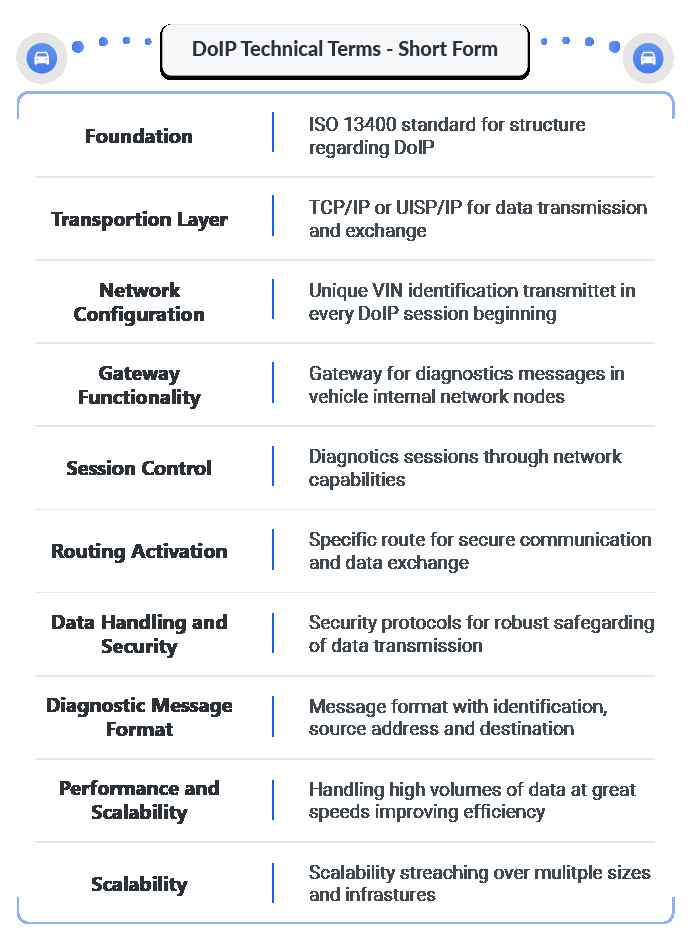 Listed special Core Technical Aspects about DoIP and what it brings to vehicle diagnostics
Listed special Core Technical Aspects about DoIP and what it brings to vehicle diagnostics
Core Technical Aspects of DoIP
-
Protocol Basics:
- Foundation: DoIP is built on the ISO 13400 standard, which defines the structure for diagnostic communication over Ethernet.
- Transport Layer: DoIP employs TCP/IP (Transmission Control Protocol/Internet Protocol) or UDP/IP (User Datagram Protocol/Internet Protocol) for data transmission, ensuring reliable and efficient data exchange based on the specific application requirements. TCP/IP provides reliable, connection-oriented communication, while UDP/IP offers connectionless communication with lower overhead, suitable for certain diagnostic data streams.
-
Network Configuration:
- Vehicle Identification: Each vehicle on a DoIP network is uniquely identified by its Vehicle Identification Number (VIN). The VIN is transmitted at the start of every DoIP session, enabling precise vehicle identification and diagnostic routing.
- Gateway Functionality: The DoIP gateway within the vehicle acts as a central routing point for diagnostic messages. It directs messages between external diagnostic tools and the vehicle’s internal network nodes, ensuring that diagnostic requests and responses reach the correct electronic control units (ECUs) within the vehicle.
-
Session Control:
- Diagnostic Session Initiation: DoIP allows diagnostic sessions to be initiated over the network, eliminating the need for physical connections. This remote session initiation is a key enabler for remote diagnostics and OTA updates.
- Routing Activation: To ensure secure communication, DoIP implements routing activation mechanisms. These mechanisms establish a dedicated communication path for diagnostic data exchange, protecting against unauthorized access and ensuring data integrity during diagnostic procedures.
-
Data Handling and Security:
- Encryption and Authentication: DoIP incorporates robust security protocols to protect data transmission. Encryption techniques safeguard data confidentiality, while authentication mechanisms verify the identity of communicating parties, preventing data interception and manipulation.
- Diagnostic Message Format: DoIP utilizes a standardized message format that includes the VIN, source address, and target address. This standardized format enhances clarity and accuracy in diagnostics by providing structured and easily parsable diagnostic messages.
-
Performance and Scalability:
- High-Speed Data Transfer: DoIP is designed for high-speed data transfer, capable of handling large data volumes at significantly faster rates than traditional diagnostic protocols. This high-speed capability dramatically reduces diagnostic times and accelerates system updates, crucial for managing the increasing complexity of vehicle software and electronics.
- Scalability: DoIP easily scales to accommodate different network sizes, from individual vehicles to large fleets, without requiring substantial infrastructure modifications. This scalability makes DoIP a versatile solution for diverse automotive applications.
Advantages of Technical Implementation
DoIP’s technical attributes contribute significantly to its effectiveness in automotive diagnostics:
- Efficiency: Reduces diagnostic and software update times, enabling faster turnaround in vehicle maintenance and repair operations.
- Flexibility: DoIP can be deployed in various settings, from small repair shops to large manufacturing plants, with minimal adaptation, offering broad applicability across the automotive industry.
- Cost-Effectiveness: Decreases the need for extensive hardware setups and reduces operational costs over time due to its network-based nature, leading to long-term cost savings for automotive businesses.
By harnessing the power of IP networks, DoIP not only enhances the capability and efficiency of vehicle diagnostics but also ensures improved security and adaptability for future technological advancements in the automotive domain.
DoIP vs. Traditional Diagnostic Protocols
Comparing DoIP with traditional diagnostic protocols highlights its advanced capabilities and practical advantages in modern automotive diagnostics.
| Feature | DoIP | Traditional Protocols (e.g., CAN, K-Line) |
|---|---|---|
| Network Integration | Utilizes IP networks, enabling diagnostics and updates over Ethernet or Wi-Fi, providing network flexibility and remote capabilities. | Relies on point-to-point connections like CAN (Controller Area Network) or K-Line, limiting connectivity and requiring physical access. |
| Data Transfer Speed | Supports high-speed data transmission, surpassing USB or conventional serial connections, crucial for handling the large data demands of modern vehicle systems and rapid software updates. | Limited by slower transmission rates, leading to longer diagnostic times, particularly with increasing data volumes in contemporary vehicles. |
| System Compatibility | Seamlessly integrates with modern vehicle electronics and telematics systems, supporting advanced features like ADAS, OTA updates, and complex ECU architectures. | May face compatibility challenges with newer systems, potentially requiring additional bridging hardware or adaptations to interface with modern vehicle technologies. |
| Scalability | Easily adaptable to both small garage setups and large-scale automotive plants with minimal infrastructure changes, offering scalability for diverse operational environments. | Scaling up often necessitates extensive hardware investments, making it less flexible and potentially more costly for larger deployments. |
| Operational Cost | Minimizes the need for extensive physical diagnostic setups, reducing labor and hardware costs, leading to lower operational expenses and improved cost-efficiency. | Higher ongoing costs may arise from manual testing requirements and the need for physical connections, potentially increasing labor and hardware expenditures. |
DoIP is not only equipped to meet the current demands of vehicle diagnostics but also anticipates future needs with its scalable, efficient, and flexible architecture. Compared to traditional protocols, DoIP is better suited to handle the sophisticated diagnostics required by modern vehicles, making it a strategic investment for the future of automotive technology.
AutoPi DoIP Solution: Elevating Vehicle Diagnostics
AutoPi leverages DoIP technology to enhance automotive diagnostics and firmware updates through our advanced fleet maintenance solutions, engineered for seamless integration and superior performance.
Our key features include:
-
Real-time diagnostics: Enables immediate issue detection and resolution, minimizing vehicle downtime and maximizing operational efficiency.
-
Over-the-air (OTA) updates: Ensures vehicle software is always up-to-date and secure, utilizing DoIP’s robust network capabilities for efficient software management.
-
Advanced security protocols: Protects data during transmission, enhancing data security across all operations and safeguarding sensitive vehicle information.
Stay Updated with Your ECU! Unlock real-time insights and optimize your driving with AutoPi TMU. Be in tune with your ECU.
Learn more
- Modern vehicles, with their complex electronics and software, are increasingly vulnerable. AutoPi’s DoIP solution addresses these vulnerabilities by providing a secure and efficient diagnostic platform.
- Utilizing Ethernet, AutoPi’s DoIP solution enables faster and more reliable remote diagnostics and ECU flashing, enhancing both speed and reliability of critical vehicle maintenance operations.
- DoIP, as a critical protocol for modern automobiles, revolutionizes ECU diagnostics by leveraging faster and more reliable communication channels, ensuring efficient vehicle management.
- Compliant with ISO 13400 standards, AutoPi’s DoIP solution is ready-to-deploy, enabling rapid implementation of remote vehicle diagnostics tailored to specific production and operational needs.
For further information on our DoIP capabilities and integration, please contact us.



